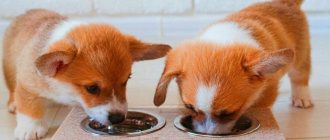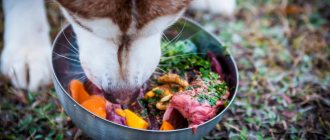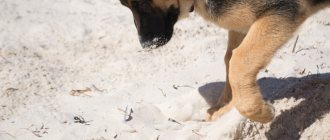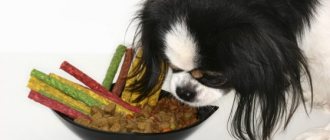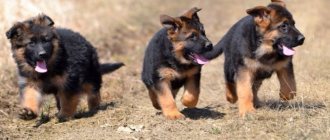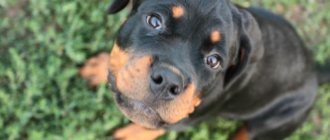At what age do you start training?
Puppy training must begin from the very first days
the presence of a dog in your home. Because already from infancy, the puppy must learn the rules of behavior in your house, what is allowed and what is forbidden, how to behave with all family members, even the smallest and oldest, what he can play with and what he can’t, where to go. toilet and much more.
And we are talking, first of all, about the proper upbringing of an American Pit Bull Terrier puppy, and you can start training and learning commands when the puppy is completely comfortable in your home. As a rule, one week is enough. By this time, the puppy is already filled with curiosity and is diligently exploring the world around him. If, after this time, the puppy remains fearful and does not make contact well, then it is better to seek help from a dog handler-animal psychologist, because This behavior is not typical for puppies of this breed.
When can you start training with a dog handler?
The beginning of the puppy's training coincides with the time of the first exit to the street. When the first two vaccinations have already been done, the quarantine (lasts 7-14 days, depending on the vaccination) after them is over. It is not at all necessary to train your puppy only outside; the first sessions are best done at home, where there are fewer distractions.
Often new puppy owners worry that training from the first days will be excessively stressful for the dog. This is only possible if outdated, rigid methods are used, and with the right approach, training from the first days will, on the contrary, be very useful, since it allows you to immediately establish contact
with the puppy and build a trusting relationship.
You can start raising a puppy from the first days of its appearance in your home, and training and classes with a dog handler can begin simultaneously with the start of walks, when quarantine ends after the second vaccination.
Why you don't need to wait up to 6 months
You often hear that American Pit Bull Terriers, like other dogs, cannot be trained before 6 months, because training is stressful. This opinion remains from the times of outdated methods based on cruel coercion and intimidation of the dog. Unfortunately, there are still plenty of dog handlers using similar techniques today. But fortunately, science does not stand still and modern techniques make it possible to train a puppy from the first days in a new home. Therefore, you should not wait until your American Pit Bull Terrier puppy develops unwanted behavior; you can start training much earlier.
Natural feeding
If you decide to feed your pit bull natural food, then create a detailed menu for him. It should include meat, vegetables, and sour milk.
An adult dog should be given about 400 grams of lean beef per day. You can give lamb and rabbit meat. Don't forget about offal (liver, heart). Cottage cheese and eggs are also useful. Eggs should be given twice a week. Be sure to include fish, vegetables and fruits in your diet. You can pamper yourself with pita and cheese.
When feeding naturally, it is important to know what not to feed your pit bull terrier.
Training at 2 months. Upbringing
At 2 months old, your American Pit Bull Terrier puppy is still at home, in quarantine after the first vaccinations, and he is not yet allowed to go for walks. Therefore, it’s time to start raising a puppy in the home conditions that are already familiar to him.
Toilet training
The first step is teaching the puppy to go to the toilet in a diaper . You should not rush to teach going to the toilet directly outside, bypassing this stage, because puppies are not physiologically ready for walking twice a day. This ability is developed in American Pit Bull Terrier puppies no earlier than 6 months, and in some up to 1 year.
It should be remembered that any learning is a rather complex thing and, seeing the first positive results, you should not think that your puppy has already understood everything, but you should continue training according to the method, so that after a while you do not have to start all over again.
Collar and leash training
The second important point will be to accustom the puppy to a collar and leash . Yes, yes, this should be done at home, so that by the time the puppy goes outside for the first time, wearing a collar will not be additional stress for him, but is already a familiar thing, and he can start exploring the world around him, rather than trying to get rid of an unknown object.
What to allow a puppy and what not
The third point, which causes the greatest difficulty for new puppy owners, will be determining the puppy’s boundaries of what is permitted. Often, many novice dog owners think that the unwanted behavior of an American Pit Bull Terrier puppy will “go away on its own, outgrow it.” But, unfortunately, the behavior that is allowed for a puppy will be taken for granted later by an adult dog.
.
Any unwanted behavior in a puppy WILL NOT go away on its own, but will only become stronger over time.
Therefore, it is necessary to start defining the puppy’s boundaries of what is permitted now. You will need:
- Teach to play only with your toys, and not with your things;
- Explain that you cannot bite your hands even in a game;
- Establish the correct daily routine, establishing the rule that in the morning you need to sleep and not wake you up;
- Stop chewing furniture, clothes, walls and baseboards;
- Teach to stay home alone, knowing that your absence is not a reason to bark or howl.
IT IS EXTREMELY IMPORTANT TO KNOW: constant and excessive punishments that follow almost every action of the puppy have a detrimental effect on his fragile psyche and can lead to the fact that the American Pit Bull Terrier puppy grows up cowardly and embittered. For normal natural development, a puppy must have the opportunity to explore the world around him, which is currently limited to your apartment or house.
Introduction to Basic Commands
Already now you should begin to familiarize yourself with the initial obedience commands in a light playful form, while focusing on rewards for execution, because the puppy’s psyche is still quite plastic and excessive severity and exactingness can lead to the puppy being intimidated and cowardly. Therefore, it is necessary, first of all, to try to interest the puppy by offering him a toy or treat, and sometimes just praise.
What can and cannot be given to your pet
A natural diet should include:
- Dairy products.
They give kefir, fermented baked milk, cottage cheese with a fat content of 2% to 9%.
Low-fat milk is not included in the menu, as it is poorly digestible. - Meat.
Beef, veal, turkey, rabbit.
It is better to give not tenderloin, but stringy meat. Chicken is added carefully - some dogs are allergic to it. — By-products.
Liver and lungs (uncommon, they provoke diarrhea), udder, rumen, heart, stomachs.
- Cereals.
Buckwheat, rice, oatmeal, barley.
— Vegetables and herbs.
Any, with the exception of potatoes, legumes, cabbage.
They provoke gas formation. - Fruits and berries.
All unsweetened varieties.
Rarely added as a treat. - Eggs.
Chicken or quail, raw, 1 – 2 times a week.
— Sea or ocean fish.
Administer once a week.
Pre-boil, remove sharp bones. - Bran.
Add to prepared liquid food, preferably kefir.
- Rusks or biscuits.
Only as a treat.
- Vegetable oil.
Olive, sunflower, pumpkin, flaxseed. They flavor the portion. For small breeds – a few drops, for large breeds – 1 tbsp.
Fish is not as nutritious as meat. It has half the protein. Therefore, they give it 2 times more.
Breeders and veterinarians have different opinions about bones. Some recommend giving raw spongy bones and moslaks to chew on. This will help train your jaws and cleanse plaque from your teeth. Others prefer only artificial bones sold in pet stores.
One way or another, you can give bones to dogs with a full-fledged chewing apparatus and no diseases of the gastrointestinal tract.
We recommend reading: Dog hair loss: causes, treatment, prevention
You can also sometimes pamper your pet with unsalted hard cheese, nuts, and special treats for animals. It is useful to occasionally introduce a little seafood, seaweed and sauerkraut.
Important! It is strictly forbidden to feed the dog the following foods:
- sweets;
- bakery and pasta products;
- onion and garlic;
- grapes and raisins;
- smoked meats;
- pork;
- fried, spicy, pickled, peppered, salted foods;
- corn, semolina, soybeans, pearl barley;
- tubular bones;
- river fish.
Training at 3 months. Socialization
Three months is an important stage in introducing an American Pit Bull Terrier puppy to the outside world. Your first walks should be short and not too tiring for the puppy. You should start with 15 minutes, gradually increasing the walking time to 1 hour.
Correct formation of the nervous system
At this age, the puppy’s nervous system is forming.
. It has been proven that raising puppies in isolation during this important period contributed to the development of pronounced cowardice in them later. It is necessary to show the puppy as much as possible: noisy streets, large crowds of people, etc. Everything that he will have to face in later life.
This must be done very carefully, gradually, over and over again increasing the time spent in noisy places, so as not to overload the puppy or frighten him.
The territory of a country house, cottage or village are places with a minimum amount of external stimuli for a city dog. Therefore, if you plan to keep a dog in an urban environment, “growing up” an American Pit Bull Terrier puppy in such conditions depleted of irritants is unacceptable.
A city puppy must grow up in the city, in conditions that are saturated with external stimuli, such as: noisy streets, large crowds of people, other animals, birds, cyclists, cars, etc.
Meeting people and dogs
It is necessary to introduce the puppy to friendly dogs and people
so that later the puppy does not develop aggression or cowardice caused by the fear of new things and the inability to communicate and make new acquaintances. Currently, unfortunately, this is not uncommon in the behavior of adult dogs, but a fairly common problem with which people turn to our specialists for help.
Puppy behavior on the street
The emergence of new places leads to new rules that need to be consolidated:
- Now you can and should go to the toilet on the street, and not stoically endure it, carrying everything home;
- Not every new person or dog wants to communicate, so you don’t need to run headlong to meet everyone;
- Not all food is healthy, so it should only be taken from the owner’s hands.
Training and practicing commands
Training a puppy follows the same principles as at 2 months. It should be remembered that at this age puppies develop conditioned reflexes quite easily, but they are forgotten just as quickly, so you should not scold the puppy for not following commands, especially if they have not been repeated for a long time, but you should pay more attention to learning new things and repeating already covered material .
Features and diet
As a rule, purchased puppies continue to be fed the same food that they ate from their previous owners. Puppies grow very quickly and already reach the size of an adult animal at eight months.
As soon as the baby is weaned from its mother, it begins to be fed with cow's milk five times a day. Try to follow a feeding schedule at certain times . The diet of a one-month-old puppy must include cottage cheese and milk formula, and from the third month of life it is transferred to a full diet, which must be selected as follows:
- One hundred grams of fresh vegetables.
- Oatmeal and buckwheat porridge with milk.
- Fifty grams of low-fat cottage cheese.
- Fifty grams of fresh meat or boiled offal.
- Vitamins and minerals.
- A teaspoon of sunflower or olive oil.
- Fish fat.
Starting from two months, puppies are switched to dry food. Its daily norm should be one hundred and twenty grams. They get used to it gradually, starting with a few granules. At first it is given exclusively soaked in milk, and later - in its usual form. Don't give up fish food completely, use it in small quantities and remember to have clean, accessible water.
Starting from six months, pit bulls' portions increase. It already includes seven hundred grams of meat per day, and milk is completely replaced by broth. Feed bones, cartilage and lean, boneless fish once a week. A puppy's diet at six months is as follows:
- One hundred grams of buckwheat or oatmeal.
- One boiled egg.
- One hundred grams of grated carrots, pumpkin or beets mixed with meat and butter.
- One hundred milliliters of broth.
- Fifty grams of cottage cheese.
- Meat – six hundred grams.
After six months, the daily amount of meat is gradually reduced , and by nine months its norm is four hundred grams per day.
Number of feedings for a pit bull terrier puppy:
- Up to two months - at least six times a day.
- From two to three – five times.
- Up to five months - three times.
- Up to seven months of age - at least three times a day.
- Starting from eight months, dogs are transferred to two meals a day.
Training at 4 - 5 months
By this time, the American Pit Bull Terrier puppy has already become accustomed to your home and usual walking areas, and no longer needs your support and care so much. He begins to flirt with other dogs, pretend that he does not hear you when you call him, and show a certain persistence and disobedience when performing various commands.
This means it's time to move on to full training . In classes at this age you can already be persistent and demanding. At the same time, the most important thing is not to overdo it, remember that classes should bring joy to both you and your dog, and only then you can achieve the desired result.
Required commands in 4 months
What commands are practiced by an American Pit Bull Terrier puppy at 4 months:
- Calm movement next
to the owner with and without a leash, with landing when stopping, with a change in pace and direction of movement - Return to you
upon request - Staying
in a free or certain position (sitting, lying, standing) for a long time: if necessary, wait for the owner on the street, when visiting a store or other establishment - Indifferent attitude towards treats scattered on the ground
- Inhibitory command
to stop unwanted actions - Execution of a set of commands “sit”, “lie down”, “stand”
at a distance and near the leg, when giving commands by voice and gestures - Stop barking
on demand.
Feeding rules for the American Pit Bull Terrier
- Natural food can be alternated with dry food. However, you cannot mix them in one serving!
- Feed your American Pit Bull Terrier after a walk. If you change the order, a satiated pet will quickly get tired and want to sleep. In addition, if the dog moves actively immediately after feeding, this is fraught with volvulus.
- It is better to place the bowl on a stand. The height of the stand increases as the dog grows.
- Feed your American Pit Bull Terrier in one place and at the same time.
- Throw away uneaten food.
- Water (clean and fresh) should always be available.
My views on feeding dogs are very democratic. Over 15 years of owning dogs of different breeds and sizes, I have learned to weigh the pros and cons of each type of feeding. There is no single diet that is suitable for all dogs of a particular breed. Everything is individual. Look for a diet that will satisfy you and your dog.
Features of feeding a pit bull are based on the specifics of the breed. This is a sporting dog. She must be dexterous, agile, radiate health and energy. Such a dog should not be overloaded or overly muscular. A Pit Bull Terrier in good condition should have clearly visible muscles, a tucked belly, and when looking at the back from above, the lower back should be narrower than the area around the ribs. The dog should look dry rather than doughy. Pitbull is not a stuff. What is acceptable in AST should not be cultivated in APBT. Proper feeding and exercise will help maintain proper pit bull condition.
1. Natural feeding.
For a pit bull, natural feeding is animal proteins and vegetables. And no porridge. Pit bull's porridge spreads. Animal proteins include meat by-products: beef, chicken or turkey. Meat in its pure form is of little value. Chicken eggs should be given 1 pc. 3-4 times a week. Fermented milk products are also good. The only caveat. Give fermented milk separately from meat, at different feedings. Almost any vegetables. Which ones does your pit bull like best? White cabbage, cauliflower, broccoli; zucchini, pumpkin, carrots, beets, bell peppers, tomatoes. Everything is given raw, grated and mixed with meat. For better digestibility, add 1 tbsp. a spoonful of any vegetable oil, olive oil is the best, but sunflower oil is also okay. You can give fish, but not all pit bulls digest it well, and it contains few nutrients. Fish with vegetables can be given for weight loss. No bread or crackers. The number of feedings varies depending on the time of year. In hot summers, 1 feeding per day, and in winter 2.
2. Dry food.
Any premium or super premium class. Just not economical. All food containing dyes or protein-mineral concentrate in the composition belongs to the economy class. If the breeders fed mom and puppies food, then stay on the same brand of food. There is no point in recommending a brand of food. Everything is individual. Sometimes a reaction to food may only appear on the second bag, a month later. Try it. If your pit bull terrier is sick and requires a certain diet, then it is worth considering medicinal lines of food. Large manufacturers offer therapeutic diets for various diseases. You can get acquainted with the line of medicinal feeds in more detail. The food can be given dry or soaked in water or broth. The number of feedings is 1-2 times a day. The serving size is set individually. Water must be available at all times. If you keep your pit bull in a cage, buy a water bowl with a cage attachment.
3. Mixed feeding
. For busy owners. ATTENTION! Not all pit bulls are suitable for a mixed diet. With mixed feeding, you give food one time and natural food the second time. With such feeding it is very difficult to choose the right portions, but with experience everything will settle down. The optimal solution for working owners. Before work, you pour dry food into a bowl, and in the evening you mix the meat with vegetables and butter.
IMPORTANT!
Training treats also contain calories. Take this into account when planning your diet.
The American Pit Bull Terrier is a powerful and athletic dog. This is a good guard and affectionate friend. You have purchased a puppy of a fairly serious breed. This means that they must provide him with good maintenance and proper feeding.
Feed your puppy correctly.
Very young puppies 1-2 months old are fed frequently - approximately 5-6 times a day. Try to give food at regular intervals to help puppies develop a routine. Remember to provide your dog with constant access to water. A puppy at the age of 1 month is still just a baby; his diet should be dominated by dairy products - cottage cheese, various mixtures. They must be given in small portions - approximately 50-100 grams
At the age of 2-4 months, complete complementary foods can be introduced.
An approximate diet for a 2-4 month old puppy should look like this:
- 50-100 grams of meat (every day)
- Beef liver, heart (once or twice a week)
- Dairy products – cottage cheese – 50-70 grams
- Vegetables (beets, carrots) – 100 grams (daily)
- Porridge with milk (oatmeal, buckwheat)
- Vitamins (vitamin complexes can be purchased at a pet store)
Veterinarians advise giving your puppy fish oil.
First, one drop at a time. Look at the reaction - if the dog accepts fish oil normally, increase the dose to three drops.
If you are purchasing a pit bull puppy from a breeder that is over two months old, it is best to inquire about the dog's diet at the kennel. And then stick to the given diet.
Important! Do not switch your puppy to mixed feeding. This can lead to digestive problems.
Feeding a pitbull puppy 6 months of age and older differs more in the amount of food. An adult puppy needs to increase the portions of meat - approximately 700 grams per day. The emphasis is on protein foods. Gradually remove milk from your diet. The puppy will have enough cottage cheese. An adult puppy should be given bones or solid food once or twice a week. Add also fish (not bony, not fatty). It is very healthy for dogs and contains many vitamins.
An adult pit bull is fed twice a day.
Training from 6 months
At this age, the puppy begins puberty and the real rebel awakens in him. He begins to re-test the boundaries of what is permitted and, sometimes, deliberately does not respond to your commands, only in order to look at your reaction. If she is not what the puppy expects to see, then he may decide that now he can no longer carry out your commands.
Remember that a puppy is still a child.
, and excessive harshness can forever undermine his trust in you.
At this stage of maturation of an American Pit Bull Terrier puppy in training, all the shortcomings made at the previous stages, which were smoothed out by his young age, become clearly visible. And if they appear, it’s time to correct them.
In many training schools, there is an opinion that a puppy needs to be trained in two stages, the first at an early age, and the second at 8 - 10 months, in order to “consolidate” what has been learned. This is not an entirely correct position; this opinion appeared when newer operant training methods began to be added to the old “DOSAAF” rigid training methods, where they began to work with the puppy strictly after 6-7 months, including working with the method of pointing and following the “target”.
Their weakness was that they were two different techniques.
, which began to be used without adapting to each other, having a huge gap between their tools for developing training skills. The difference between them is like between choreography lessons in kindergarten and army drill training. Therefore, they required training in two stages, which were in no way connected with each other.
Modern methods based on zoopsychology make it possible to train a puppy in a single system , when no additional stages of training are required.
Natural feeding for the American Pit Bull Terrier
If you choose natural feeding, you will have to make efforts to create a proper, balanced diet. We suggest including the following ingredients:
- Raw meat (preferably beef, you can - but be careful - give rabbit or poultry) - 1/3 of the diet.
- You can replace meat with boiled offal (heart, beef liver, kidneys, heart or lungs) 1-2 times a week, but you need 1.5 times more offal than meat.
- Raw vegetables (spinach, cucumbers, beets or carrots), grated, with the addition of vegetable oil.
- Fermented milk products (cottage cheese, kefir), but they should be low-fat.
When feeding “natural” food, you will have to include vitamin and mineral supplements in your American pit bull’s diet. However, before purchasing them, consult your veterinarian.
Our dog handlers
American Pit Bull Terrier training specialists
Alexander Chaplygin Dog psychologist-zoopsychologist
Experience: 37 years Read more..
Ekaterina Panova Dog psychologist-zoopsychologist
Experience: 34 years Read more..
Yaroslav Morozov Dog psychologist-zoopsychologist
Experience: 25 years Read more..
Lada Yurtseva Dog psychologist-zoopsychologist
Experience: 21 years Read more..
Victoria Fox Dog psychologist-animal psychologist
Experience: 14 years Read more..
Ekaterina Budkina Dog psychologist-zoopsychologist
Experience: 13 years Read more..
Evgeniy Bravinsky Dog psychologist-zoopsychologist
Experience: 17 years Read more..
Vitalia Bravinskaya Dog psychologist-zoopsychologist
Experience: 10 years Read more..
Kira Ageeva Dog psychologist-zoopsychologist
Experience: 19 years Read more..
Evgenia Zuber Dog psychologist-zoopsychologist
Experience: 12 years Read more..
Tatyana Melnikova Dog psychologist-zoopsychologist
Experience: 10 years Read more..
Alexey Melikhov Dog psychologist-zoopsychologist
Experience: 22 years Read more..
* Check with the managers for the possibility of a specific specialist visiting the area you specified. If the desired dog handler does not work in your area, then we can offer you another specialist from the above.
Training an American Pit Bull Terrier puppy in
When you turn to our dog training center for help in training an American pit bull terrier puppy, you can be sure that a real specialist in his field
and will provide training at the proper, highest level.
- A dog trainer will come to your
home at a time convenient for you. - Classes are held 1-2 times a week
, depending on the program. - Instructors work from 9:00 to 21:00
, on weekends inclusive - The training program is drawn up at the first lesson,
taking into account the breed, age, personal characteristics of the dog and your wishes for training - Some classes take place at home
, some
outside
, depending on the topic of the lesson. - Puppy age
from 2 months
Our Center employs dog handlers - animal psychologists who have experience in working with American Pit Bull Terrier puppies and training adult dogs from 10 to 35 years old, who know all the nuances of their behavior
and features of training at each stage of a dog’s growth. Therefore, your pet is guaranteed to learn to carry out your commands the first time in any conditions, and will become your faithful and reliable companion.
Feeding a pit bull with natural products
Pitbull puppies are fed 4-6 times a day with high-calorie food with all the necessary vitamins, but the doses should be small in order to be better absorbed. The daily diet must include 100 grams of meat, and once a week, veal or chicken heart or liver.
Pork is prohibited for pit bulls; it is better to give beef.
Also, once a week, instead of one meal of meat, 50 grams of boneless sea fish are given. Although many pit bulls love fish, they can have a fish day twice a week.
Every day the puppy needs 50 g of low-fat cow's cottage cheese, 100 g of grated carrots or apples, one boiled egg, and milk. Also, liquid porridges are cooked in milk for the puppy:
- Hercules,
- buckwheat,
- millet,
- wheat.
As the puppy grows older, the amount of food increases, and the number of meals decreases and by one year it is equal to two. A teenage pit bull at the age of seven to eight months needs more meat than an adult dog - up to 600 grams per day, but after nine months of age this norm should be reduced to 450-500 grams.
Due to the characteristics of their coat and skin, pit bulls are prone to the formation of wen, and this is directly related to the quality of nutrition. If such problems arise, you need to seriously reconsider the dog’s diet. It should not contain flour or sweets; the amount of animal fats (butter, sour cream) should be limited to a minimum.
Feeding a pit bull dry food
A small pit bull can be switched to dry food from the age of two months. For this purpose, special food for puppies of very good quality is selected and initially given in separate granules as a treat.
You need to observe for a couple of days to see if signs of allergies or eating disorders appear. If they are not there, then the daily dose for such a baby is 120 grams, which is divided into several doses. The food is lightly soaked in water, milk or kefir. The puppy must have constant access to fresh water.
An adult dog also needs high-quality food designed for large breed dogs. At the same time, the feed should contain no more than 26% protein. It is equally important to monitor the balance of phosphorus and calcium. Excess phosphorus leads to disorders in the nervous system, for example, the development of pathological cowardice.
That’s why some breeders do not recommend buying fish-based food for your pit bull. Even if the selected dry food contains enough of all the substances the dog needs, it sometimes needs to be given raw vegetables and cartilaginous bones to prevent the formation of tartar.
Did you like it? Share with your friends!
Give it a like! Write comments!
